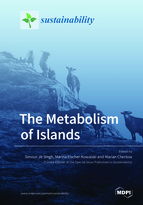The Metabolism of Islands
A special issue of Sustainability (ISSN 2071-1050). This special issue belongs to the section "Social Ecology and Sustainability".
Deadline for manuscript submissions: closed (30 September 2020) | Viewed by 47185
Special Issue Editors
Interests: social metabolism; ecological economics; industrial ecology; material and energy flows; time use; local studies; sustainable resource use on small islands
Interests: social metabolism; socioecological transitions; theories of social change; social ecology; sustainable resource use; environmental sociology
Interests: industrial environmental management; industrial symbiosis; circular economy; waste management
Special Issues, Collections and Topics in MDPI journals
Special Issue Information
Dear Colleagues,
Based on a materials stock and flow principle, the field of Industrial Ecology systematically analyzes interactions between human/industrial activities and the environment, in order to move towards practices that are sustainable in the long-term. The emphasis is on society’s resource use and resource efficiency at multiple scales. The concept of “social metabolism" and its accounting framework, Material and Energy Flows Analysis (MEFA), have made considerable advancements in the ability to measure resource throughput for understanding long-term trends in national and global resource use, decoupling, and circular economy.
Islands are excellent focal points for studies of Industrial Ecology. Not only does the clear boundary of islands simplify tracking resource flows, but the limited resource availability and carrying capacity of small islands warrant better tracking and management of these inputs and outputs. The challenge of resource security on small islands is further aggravated by the global environmental change. Sea level rise and extreme weather events result not only in infrastructure losses but also in the immediate loss of critical services. Restoring the services provided by these stocks comes with large material requirements for reconstruction, oftentimes incurring huge debts.
This Special Issue invites contributions that look at material stocks and flows on small island states (SIS) and sub-national island jurisdictions (SNIJ), how such insights can support island societies to move towards more sustainable and resilient modes of production, consumption and infrastructure development. The special issue will also consider compelling contributions related to island sustainability in general.
Prof. Dr. Simron Singh
Prof. Dr. Marina Fischer-Kowalski
Prof. Dr. Marian Chertow
Guest Editors
Manuscript Submission Information
Manuscripts should be submitted online at www.mdpi.com by registering and logging in to this website. Once you are registered, click here to go to the submission form. Manuscripts can be submitted until the deadline. All submissions that pass pre-check are peer-reviewed. Accepted papers will be published continuously in the journal (as soon as accepted) and will be listed together on the special issue website. Research articles, review articles as well as short communications are invited. For planned papers, a title and short abstract (about 100 words) can be sent to the Editorial Office for announcement on this website.
Submitted manuscripts should not have been published previously, nor be under consideration for publication elsewhere (except conference proceedings papers). All manuscripts are thoroughly refereed through a single-blind peer-review process. A guide for authors and other relevant information for submission of manuscripts is available on the Instructions for Authors page. Sustainability is an international peer-reviewed open access semimonthly journal published by MDPI.
Please visit the Instructions for Authors page before submitting a manuscript. The Article Processing Charge (APC) for publication in this open access journal is 2400 CHF (Swiss Francs). Submitted papers should be well formatted and use good English. Authors may use MDPI's English editing service prior to publication or during author revisions.
Keywords
- social metabolism
- material and energy flows
- small islands
- island industrial ecology
- resource use
- resource efficiency
- circular economy






